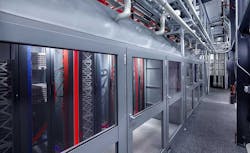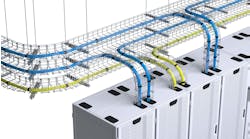Manufacturers Must Manage an Explosion of Industry Data – Is Edge Computing the Answer?
Carsten Baumann, Director of Strategic Initiatives and Solution Architect at Schneider Electric, explores the role of edge computing in handling today’s big data explosion in the manufacturing sector.
Carsten Baumann, Director of Strategic Initiatives and Solution Architect, Schneider Electric
The rise of Industry 4.0 is taking manufacturing plants to the next level, not only in how it is enabling manufacturers to automate and connect devices, but in how they apply data and analytics to make more informed, real-time decisions. Manufacturers are generating high fidelity Industrial Internet of Things (IIoT) data to create a more connected production ecosystem and generate the insights needed to increase efficiency and reliability.
The growth of IIoT data has been dramatic and our reliance on it is growing. In fact, McKinsey & Company estimates that companies will spend between $175 billion and $215 billion on IIoT hardware by 2025, including computing hardware, sensors, firmware and storage.
As the amount of IIoT data being produced increases, so too does the amount of data that needs to be processed and stored. This is driving many manufacturers to rethink traditional strategies involving regional enterprise, colocation or cloud data centers and shift to also include industrial edge computing.
Key Data Processing Factors to Keep in Mind
When choosing between industrial edge computing, larger regional enterprise or colocation data centers and cloud data centers, what considerations should manufacturers keep in mind?
Businesses need to explore four main factors about the data in question: volume, variety, value and veracity. Once they do so, it’ll be easier to determine what IT solutions to invest in to best fit your IIoT applications.
- Volume: Today’s IIoT environments generate large amounts of data that must be processed and analyzed. For example, simple data points within a manufacturing plant like temperature, pressure, time and volume levels tend to be measured occasionally whereas a sensor that monitors a specific process on the plant floor can easily generate gigabytes of data every second. This type of data processing requires different network, compute and storage considerations.
- Variety: IIoT applications can produce a variety of data for each application. For example, a sensor that measures temperature may differ from one application to the next, so the types of data can vary dramatically depending on the relevant applications.
- Value: This determines what data is needed and how long it should be stored. Ifyou measure pressure as part of a manufacturing process, manufacturers need to determine if the data has value once the process has been completed.
- Veracity: When dealing with massive data streams, manufacturers need to consider the veracity of the data and whether it’s accurate. With large amounts of data, some amount is likely to represent outliers. For example, in a process that measures the diameter of an object, this activity may create vibration, which in turn creates data that represents random noise instead of the measurement itself. Manufacturers don’t need to keep this data, so they must put parameters in place to extract irrelevant data and verify the quality of the data that is relevant.
Once businesses evaluate how the above characteristics affect their IIoT applications, they’ll be able to determine where their data should be processed, stored and transported. Most modern industrial processes require real-time analysis, meaning it should be done locally in edge data centers rather than the analysis taking place in offsite cloud platforms.
While the hype around edge computing has been growing across industries for years now, there’s no denying that the COVID-19 pandemic is acting as a forcing function to get industrial companies more interested in the benefits edge computing provides in supporting remote operations, real-time control and enhanced data-crunching capabilities.
While real-time processing and analytics are a must for most businesses these days, bandwidth, network capacity and cost are also large factors that are driving more industrial companies to the edge as they realize the benefits that enhanced real-time control offers enterprises in today’s increasingly complex environment. Analytic results and additional process data may then be transported and stored elsewhere for record keeping, such as traceability and compliance.
COVID-19 Accelerates the Industrial Edge
As we rely more heavily on IIoT applications, industrial enterprises will require storage and processing solutions that support the agility and efficiency needed in today’s increasingly complex and challenging business environment. They’re turning to edge computing to do just that. In fact, a recent Frost & Sullivan report found that 90% of industrial enterprises will utilize edge computing by 2022. That’s a dramatic shift from a few years ago when the vast majority of enterprises didn’t account for edge in their IT strategies.
While the hype around edge computing has been growing across industries for years now, there’s no denying that the COVID-19 pandemic is acting as a forcing function to get industrial companies more interested in the benefits edge computing provides in supporting remote operations, real-time control and enhanced data-crunching capabilities. We predict that as we get deeper into the Industry 4.0 era, the industrial edge will only continue to accelerate.
Manufacturers are operating in two different domains – the edge control layer, where data is analyzed and decisions are made in real-time, and the apps and analytics layer using Cloud, where data is gathered to create data lakes that can be mined to create further insights and comparisons.
To address the challenges brought on by Industry 4.0 – and those that were accelerated because of the COVID-19 pandemic – manufacturers should consider leaning more heavily into the industrial edge to improve real-time analysis, reduce latency and improve the amount of data being processed from across the enterprise. By combining the computing power of the apps and analytics layer with the speed of the edge layer, manufacturers can access high-quality insights in real-time to improve reliability, efficiency and, ultimately, operational profitability.
Carsten Baumann is Director of Strategic Initiatives and Solution Architect at Schneider Electric.





